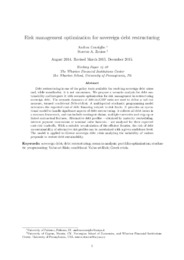Risk management optimization for sovereign debt restructuring

View/
Date
2015-12Publisher
Journal of Globalization and Development, Vol. 6(2), pp. 181–213, Feb. 2016.; The Wharton School Financial Institutions Centre No. 14-10.Google Scholar check
Keyword(s):
Metadata
Show full item recordAbstract
Debt restructuring is one of the policy tools available for resolving sovereign debt crises and, while unorthodox, it is not uncommon. We propose a scenario analysis for debt sustainability and integrate it with scenario optimization for risk management in restructuring sovereign debt. The scenario dynamics of debt-to-GDP ratio are used to define a tail risk measure, termed "conditional Debt-at-Risk". A multi-period stochastic programming model minimizes the expected cost of debt financing subject to risk limits. It provides an operational model to handle significant aspects of debt restructuring: it collects all debt issues in a common framework, and can include contingent claims, multiple currencies and step-up or linked contractual features. Alternative debt profiles -- obtained by maturity rescheduling, interest payment concessions or nominal value haircuts -- are analyzed for their expected cost-risk tradeoffs. With a suitable re-calculation of the efficient frontier, the risk of debt unsustainability of alternative risk profiles can be ascertained with a given confidence level. The model is applied to Greece sovereign debt crisis analyzing the suitability of various proposals to restore debt sustainability.

